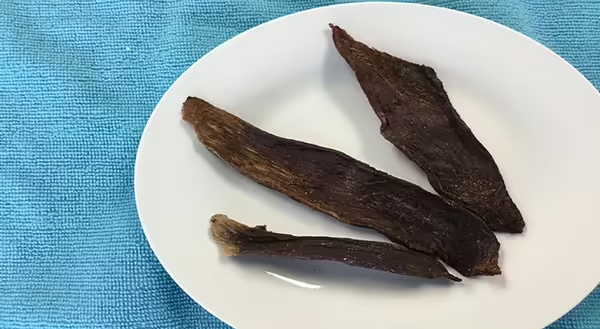
Jerky is a dried meat product that comes in as many different flavors and uses as many different meats as you can probably think of. While jerky can be made at home, this post will focus on prepared jerky.
Nutrition
The nutrition of jerky will vary based on the type of protein used and any flavorings. For nutrition information on your specific jerky, check the food label.
In general, a half cup of beef jerky contains around 180 calories and has 15g protein, 10g fat, 5g carbohydrate, and 930mg sodium. Vitamins and minerals for beef jerky include folate, vitamin B-12, iron, and magnesium.
Meat on its own does not contain a significant amount of carbohydrates. Usually carbohydrates in jerky come from the marinade ingredients, such as sugar. Jerky does not contain significant amounts of fiber.
- Buy: Choose jerky before the “use by” date on the package. While dried foods are shelf stable, jerky quality does go down over time, such as drying out further or tasting rancid.
Sodium is very high in most brands of jerky. When eating jerky, be sure to eat low-sodium foods throughout the rest of your day to balance your sodium intake. Or buy lower sodium brands of jerky. They do exist!
- Price: Price will vary by brand, animal protein, and other factors. Buy a jerky you will eat that is within your budget.
- Store: Jerky can be stored at room temperature, and will last longer in a refrigerator. Read the package of your brand of jerky to learn how they recommend storing their jerky. Remember, fat in meat does go rancid over time and affects the flavor of jerky. Pressing as much air out of the jerky package will also limit oxygen exposure that speeds up fat going rancid.
- Prepare: Jerky really needs no preparation. Open and eat! It’s always a good idea to wash hands before eating food.
- Eat: While many individuals eat jerky on its own, there are ways to add jerky to recipes. Primarily, this includes reconstituting the dry jerky by moist cooking, such as with stew or pasta sauces.
Were you looking for information on making your own jerky? Check out our sister blog, Know How, Know More, for that post.
Healthy Eats and Repeat
How much difference is there between canned and frozen foods? How should you cook venison? When is the best time to buy avocados? Get answers to these questions as well as other tips, tutorials and recipes for common kitchen foods and items with University of Illinois Extension Nutrition & Wellness Educator Caitlin Mellendorf’s blog Healthy Eats and Repeat. Build your best life. Trust Extension to help.
Caitlin Mellendorf is an Illinois Extension Nutrition and Wellness Educator serving DeWitt, Macon and Piatt Counties in Central Illinois. She is a Registered Dietitian and her work focuses on helping community members gain the knowledge, skills and tools to live healthier, more nutritious lifestyles. This includes providing programs and answering questions about heart health, diabetes, food safety, food preservation, grocery shopping and cooking. You can reach Caitlin by email at chuth2@illinois.edu or call 217.877.6042. Check out her nutrition blog Healthy Eats and Repeats for seasonal recipes and of an exploration of common kitchen foods.